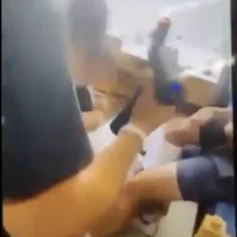A memorial project honoring the lives of those lost to racial violence is giving the “say their name” movement a greater sense of permanency through quilting.
In the past year, the Stitch Their Name Memorial Project — made up of 75 stitchers from across the U.S. and other countries — has put together two quilts immortalizing 116 Black men and women.

Holli Johannes, a high school math teacher in Eugene, Oregon, came up with the idea of the quilt project while witnessing the growing civil unrest spurred by acts of racial violence and injustice.
The project’s site reads that by displaying the quilts across the country, “We hope to bring additional critical awareness to the collective loss and the horrific magnitude of Black persons being targeted by racism and bigotry in this country.”
Squares of stitching create portraits of those lost from the likes of Dr. Martin Luther King Jr. to George Floyd to Ahmaud Arbery to Sandra Bland to countless others. Many of the victims’ biographies reveal they were fatally shot or injured by police, or by other instances of hate carried out by an unsuspecting passerby.
Such was the case when Rev. Daniel Simmons Sr. and eight others were wounded and killed in a South Carolina church shooting by self-identifying white supremacist Dylann Roof.
Like so many other lives, Simmons is memorialized on a quilt. It also includes hopeful Olympic runner James Earl Green, who with another individual was fatally shot by police while the two were making their way through the campus of Jackson State University.
Green was only on campus as a means of getting home from his job at a local grocery store. At the time police were called to the historically Black university in response to protests against racial injustices. For his sister, seeing the quilt evoked deep emotion of how little times have changed.
“Now today, you see them saying ‘Black Lives Matter,’ and that really grieves my spirit. We’ve come a long way, but we still got such a long way to go,” Gloria Green-McCray told The Associated Press.
While the Stitch Their Name project may be relatively new, the art of quilting with a purpose/to convey a message is not. Dating back to the 19th century, women and people of color used quilting to record their history and to send calls of action.
“It’s a history that sometimes supersedes what can be written down. That’s significant for our community because we have been denied the privilege of being documented for so many centuries and so this is one of the ways that we resist,” explained Jackson State University English department chair Ebony Lumumba, of quilting’s history as a form of activism.
“Each little piece represents something — each piece had a significant meaning,” she continued. “It was not just a piece of cloth, but it was a piece of history, a piece of that person.”
The quilts will be on display throughout the month of January at the African American Heritage Museum of Southern New Jersey.
More news from our partners:
Surprise, Surprise: Jersey Shore Town Beats Florida Locales as Zillow Retirement Hotspot


